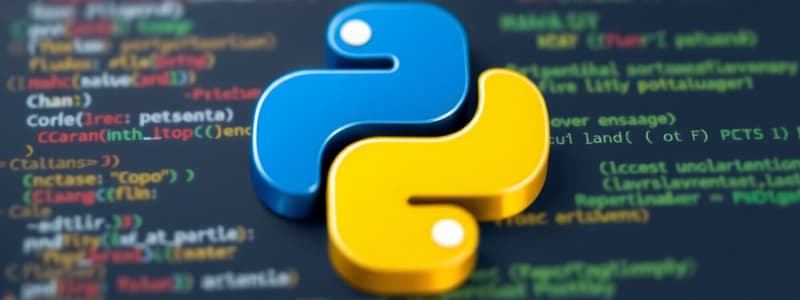Podcast
Questions and Answers
Which concept allows objects of different classes to respond differently to the same method call?
Which concept allows objects of different classes to respond differently to the same method call?
- Abstraction
- Inheritance
- Polymorphism (correct)
- Encapsulation
What is the primary function of try...except blocks in Python?
What is the primary function of try...except blocks in Python?
- To improve code documentation
- To manage file I/O operations
- To handle potential errors and exceptions (correct)
- To define custom classes
What is the recommended practice for ensuring that files are properly closed after being used in Python?
What is the recommended practice for ensuring that files are properly closed after being used in Python?
- Relying on Python's garbage collection
- Explicitly calling the `close()` method (correct)
- Using the `delete()` method
- Using a `finally` block
Which of the following is a 2-dimensional labeled data structure in Pandas?
Which of the following is a 2-dimensional labeled data structure in Pandas?
Which style guide provides coding conventions to improve the readability and maintainability of Python code?
Which style guide provides coding conventions to improve the readability and maintainability of Python code?
Which characteristic of Python allows code to be executed line by line, aiding in debugging?
Which characteristic of Python allows code to be executed line by line, aiding in debugging?
What does it mean when we say that Python is a dynamically-typed language?
What does it mean when we say that Python is a dynamically-typed language?
Which of the following data structures in Python is immutable?
Which of the following data structures in Python is immutable?
Which of the following is NOT a standard way to control the flow of execution in Python?
Which of the following is NOT a standard way to control the flow of execution in Python?
What is the primary purpose of using modules in Python?
What is the primary purpose of using modules in Python?
Which keyword is used to bring external modules into a Python program?
Which keyword is used to bring external modules into a Python program?
What's the role of a class in object-oriented programming (OOP) with Python?
What's the role of a class in object-oriented programming (OOP) with Python?
Which statement best describes Python's support for object-oriented programming (OOP)?
Which statement best describes Python's support for object-oriented programming (OOP)?
Flashcards
try...except blocks
try...except blocks
Specific blocks of code designed to handle potential errors or exceptions.
Inheritance
Inheritance
A powerful feature in object-oriented programming where a child class inherits properties and methods from its parent class.
NumPy
NumPy
A fundamental package in Python that provides powerful tools for numerical computation, including arrays and matrices.
DataFrames
DataFrames
Signup and view all the flashcards
PEP 8
PEP 8
Signup and view all the flashcards
What is Python?
What is Python?
Signup and view all the flashcards
What makes Python an interpreted language?
What makes Python an interpreted language?
Signup and view all the flashcards
Explain dynamic typing inPython.
Explain dynamic typing inPython.
Signup and view all the flashcards
How is Python object-oriented?
How is Python object-oriented?
Signup and view all the flashcards
What are Python libraries and their significance?
What are Python libraries and their significance?
Signup and view all the flashcards
Describe Python functions.
Describe Python functions.
Signup and view all the flashcards
What are Python modules?
What are Python modules?
Signup and view all the flashcards
How does Python handle control flow?
How does Python handle control flow?
Signup and view all the flashcards
Study Notes
Introduction to Python
- Python is a high-level, general-purpose programming language.
- It's known for its clear syntax, readability, and extensive libraries.
- It's widely used in various domains, including web development, data science, machine learning, scripting, and automation.
- Python's versatility and ease of learning have contributed to its popularity.
Key Features of Python
- Interpreted language: Python code is executed line by line by an interpreter, making it flexible and easier to debug compared to compiled languages.
- Dynamically typed: Variable types are checked during runtime, simplifying development but demanding careful attention to potential type-related issues.
- Object-oriented: Python supports object-oriented programming principles, enabling code organization and reusability.
- Extensive libraries: Python boasts a vast ecosystem of libraries, like NumPy for numerical computation, Pandas for data analysis, and Matplotlib for data visualization.
- Large and active community: A vast community of developers provides support, tutorials, and resources. This makes debugging and learning easier.
Basic Syntax and Data Structures
- Variables: Variables don't need explicit type declarations.
- Data types: Python supports various data types, including integers, floating-point numbers, strings, booleans, lists, tuples, dictionaries.
- Operators: Python uses standard arithmetic, comparison, and logical operators.
- Control flow: Python uses
if,elif,else,for, andwhileloops for conditional statements and iterative processes. - Lists: Ordered, mutable collections of items, accessed by index.
- Tuples: Ordered, immutable collections of items, often used for representing fixed data.
- Dictionaries: Key-value pairs, useful for representing data structures with named fields.
Functions and Modules
- Functions: Reusable blocks of code that perform specific tasks.
- Modules: Files containing groups of related functions or classes, promoting code organization and reusability.
- Import statements: Used to include external modules into a Python program.
- Function arguments: Functions can accept input values through arguments.
- Return values: Functions can return results to the calling part of the code.
Object-Oriented Programming (OOP) Concepts
- Classes: User-defined blueprints for creating objects.
- Objects: Instances of classes, encapsulating data (attributes) and methods (functions).
- Methods: Functions defined within a class.
- Inheritance: A mechanism for creating new classes (child classes) based on existing ones (parent classes).
- Polymorphism: The ability of objects of different classes to respond to the same method call in different ways.
Error Handling (Exceptions)
try...exceptblocks: Used to handle potential errors or exceptions, improving program robustness.- Specific exception handling: Different types of exceptions can be trapped and handled.
finallyblocks: Code insidefinallywill always execute, useful for cleaning up resources.
File Handling
- Opening files: The
open()function is used to read from or write to files. - Reading files: Python allows reading files line-by-line or as a whole.
- Writing to files: Python supports appending to an existing file or creating a new one.
- Closing files: Ensuring resources are released, using the
close()method.
Working with Libraries (e.g., NumPy, Pandas)
- NumPy: A fundamental package for numerical computation in Python.
- Pandas: Offers data structures and functions for data analysis.
- DataFrames: 2-dimensional labeled data structures with rows and columns.
- Series: 1-dimensional labeled array.
- Data manipulation: Pandas is used for cleaning, transforming, and analyzing data.
Common Python Development Practices
- Code style guides: PEP 8 provides coding conventions for readable and maintainable code.
- Documentation: Clearly documenting code increases its usefulness for others.
- Testing: Unit testing is essential to ensure code quality.
- Debugging: Techniques to identify and fix errors effectively.
Studying That Suits You
Use AI to generate personalized quizzes and flashcards to suit your learning preferences.




